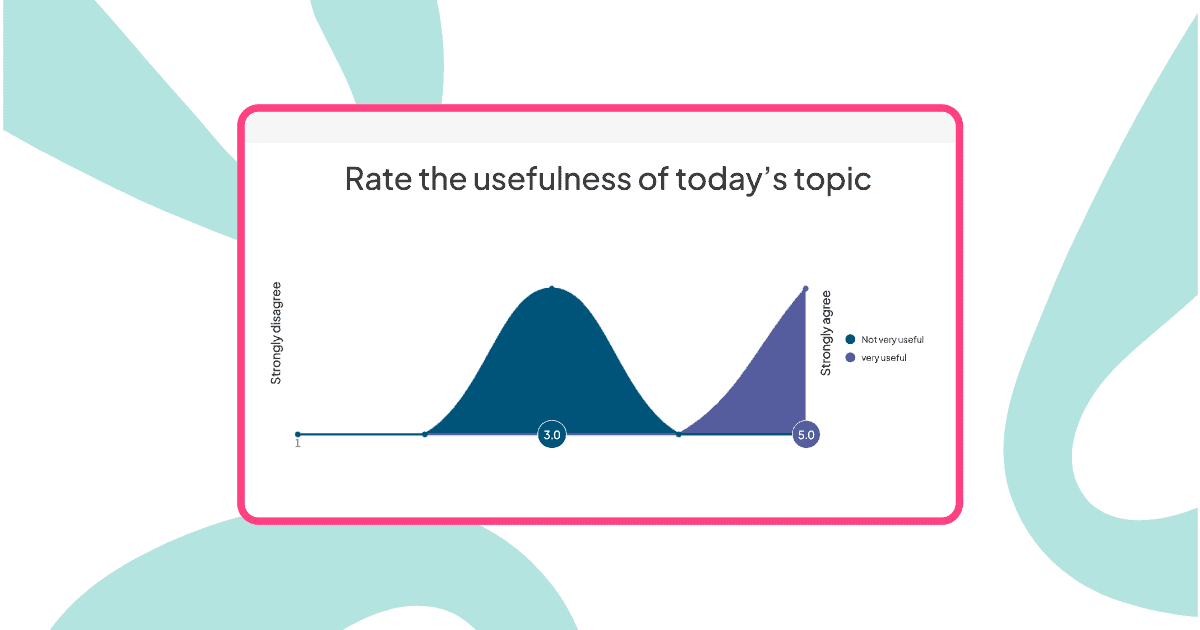Gelo te qet meraq kiriye ka karmendên te bi rastî li ser rol, beşdarî û razîbûna giştî ya karê xwe çi difikirin?
Kariyerek têrker êdî bi mûçeyekî di dawiya mehê de ve sînordar nîne. Di serdema xebata ji dûr ve, demjimêrên nerm û rolên kar ên pêşkeftî de, pênaseya razîbûna ji kar bi awayekî berbiçav guheriye.
Pirsgirêk ev e: anketên salane yên kevneşopî pir caran rêjeyên bersivdayînê yên kêm, têgihiştinên derengmayî û bersivên paqijkirî nîşan didin. Karmend wan bi tena serê xwe li ser maseyên xwe temam dikin, ji kêliyê veqetiyane û ji tirsa ku bên naskirin ditirsin. Heta ku hûn encaman analîz bikin, pirsgirêk an zêde bûne an jî hatine jibîrkirin.
Rêyek çêtir heye. Anketên razîbûna kar ên înteraktîf ên ku di civînên tîmê, civînên bajarî, an rûniştinên perwerdeyê de têne kirin, di wê gavê de - dema ku tevlêbûn herî zêde ye û hûn dikarin di wextê rast de fikaran çareser bikin - bersivên rastîn digirin.
Di vê rêbernameyê de, em ê pêşkêş bikin 46 pirsên nimûne ji bo pirsnameya razîbûna karê we, nîşanî we dide ka meriv çawa anketên statîk vediguherîne sohbetên balkêş, û alîkariya we dike ku hûn çandeke cihê kar pêş bixin ku tevlêbûna karmendan xurt dike, nûbûnê dixe û zemînê ji bo serkeftinek mayînde amade dike.
Table of Contents
- Pirsnameya Têrkeriya Kar çi ye?
- Çima Pirsnameya Razîbûna Kar Bikin?
- Cûdahiya Di Navbera Anketên Kevneşopî û Înteraktîf de
- 46 Pirsên Nimûne ji bo Pirsnameya Razîbûna Kar
- Meriv Çawa Anketek Têrkeriya Karê Bi Bandor Bi AhaSlides Dimeşîne
- Çima Anketên Înteraktîf Ji Formên Kevneşopî Çêtir Dixebitin
- Key Takeaways
Pirsnameya Têrkeriya Kar çi ye?
Pirsnameyeke razîbûna kar, ku wekî anketa razîbûna karmendan jî tê zanîn, amûrek stratejîk e ku ji hêla pisporên çavkaniyên mirovî û rêberên rêxistinan ve tê bikar anîn da ku fêm bikin ka karmendên wan di rolên xwe de çiqas razî ne.
Ew ji pirsên bi baldarî hatine amadekirin pêk tê ku ji bo vegirtina deverên krîtîk ên wekî jîngeha kar, berpirsiyariyên kar, têkiliyên bi hevkar û serperiştkaran re, tezmînat, derfetên mezinbûnê, refah û hwd. hatine çêkirin.
Rêbaza kevneşopî: Lînka anketê bişînin, li benda bersivên bi lez bisekinin, piştî çend hefteyan daneyan analîz bikin, dûv re guhertinên ku ji fikarên resen veqetandî hîs dikin bicîh bînin.
Rêbaza înteraktîf: Di dema civînan de pirsan bi awayekî zindî pêşkêş bikin, bi riya anketên anonîm û ewrên peyvan bersivên tavilê berhev bikin, encaman di wextê rast de nîqaş bikin, û dema ku sohbet teze ye bi hev re çareseriyan pêş bixin.
Çima Pirsnameya Razîbûna Kar Bikin?
lêkolîna Pew destnîşan dike ku nêzîkî %39ê karkerên ne-xwebixwe karên xwe ji bo nasnameya xwe ya giştî girîng dibînin. Ev hest ji hêla faktorên wekî dahata malbatê û perwerdehiyê ve tê şekildan, ku %47ê kesên bi dahata bilind û %53ê xwendekarên lîsansê girîngiyê didin nasnameya karê xwe. Ev têkilî ji bo razîbûna karmendan pir girîng e, û anketek razîbûna kar a baş-rêxistinkirî ji bo armanca xwedîderketinê û refahê girîng dike.
Kirina anketek razîbûna kar ji bo hem karmendan û hem jî ji bo rêxistinê feydeyên girîng pêşkêş dike:
Têgihîştineke Têgihîştî
Pirsên taybetî hestên rastîn ên karmendan eşkere dikin, nêrîn, fikar û qadên razîbûnê eşkere dikin. Dema ku bi awayekî înteraktîf bi vebijarkên bersivên anonîm têne kirin, hûn tirsa nasnameyê derbas dikin ku pir caran di anketên kevneşopî de dibe sedema bersivên nerast.
Issue Nasname
Lêpirsînên hedefgirtî xalên êşê yên ku bandorê li moral û tevlêbûnê dikin destnîşan dikin - çi bi ragihandinê, barê kar, an derfetên mezinbûnê ve girêdayî be. Ewrên peyvan ên demrast dikarin tavilê bibînin ku piraniya karmendan li ku derê zehmetiyan dikişînin.
Çareseriyên Tailored
Nirxandinên ku hatine berhevkirin rê didin çareseriyên xwerû, û pabendbûna we ya ji bo baştirkirina şert û mercên kar nîşan didin. Dema ku karmend dibînin ku nêrînên wan tavilê têne nîşandan û bi eşkereyî têne nîqaş kirin, ew hîs dikin ku bi rastî têne bihîstin ne ku tenê têne lêpirsîn kirin.
Têkilî û Ragirtina Zêdekirî
Bersivdayîna fikaran li ser bingeha encamên anketan tevlêbûnê zêde dike, dibe sedema kêmbûna rêjeya guherîna karmendan û zêdebûna dilsoziyê. Anketên înteraktîf berhevkirina nirxandinan ji karekî burokrasiyê vediguherînin guftûgoyek watedar.
Cûdahiya Di Navbera Anketên Kevneşopî û Înteraktîf de
| aspect | Anketa kevneşopî | Anketa înteraktîf (AhaSlides) |
|---|---|---|
| Demjimêr | Bi rêya e-nameyê hatî şandin, bi tena serê xwe hatî temamkirin | Di dema civînan de zindî dihat pêşkêşkirin |
| Bersiv xwar | Navînî 30-40% | %85-95 dema ku zindî tê pêşkêşkirin |
| Anonymous | Gumanbar - karmend ji şopandinê ditirsin | Nenasbûna rastîn bêyî hewcedariya têketinê |
| Destgirî | Wekî karê malê hîs dike | Wekî axaftinê xuya dike |
| results | Çend roj an hefte şûnda | Vîzyonkirina yekser, di dema rast de |
| Çalakî | Derengmayî, qutbûyî | Gotûbêj û çareserîyeke bilez |
| format | Formên statîk | Anketên dînamîk, ewrên peyvan, Pirs û Bersîv, nirxandin |
Têgihîştina sereke: Dema ku nirxandin ji belgekirinê bêtir wekî diyalogê xuya dike, mirov bêtir tevdigerin.
46 Pirsên Nimûne ji bo Pirsnameya Razîbûna Kar
Li vir nimûneyên pirsan hene ku li gorî kategoriyan hatine rêzkirin. Her beş rêbernameyek li ser ka meriv çawa wan bi awayekî înteraktîf pêşkêş dike ji bo rastgoyî û tevlêbûna herî zêde dihewîne.
Karûbarê Kar
Pirs:
- Hûn ê rehetiya laşî û ewlehiya cîhê xebata xwe çawa binirxînin?
- Tu ji paqijî û rêkxistina cihê kar razî yî?
- Ma hûn hîs dikin ku atmosfera nivîsgehê çandek xebatê ya erênî pêşdixe?
- Ma ji we re amûr û çavkaniyên pêwîst têne peyda kirin ku hûn karê xwe bi bandor bimeşînin?
Nêzîkatiya înteraktîf bi AhaSlides re:
- Pîvanên nirxandinê (1-5 stêrk) bikar bînin ku bi awayekî zindî têne xuyang kirin
- Bi ewrekî peyvan ê vekirî bidomînin: "Bi yek peyvekê, atmosfera cihê karê me rave bikin"
- Moda anonîm çalak bike da ku karmend bêyî tirs bi awayekî rastgo şert û mercên fîzîkî binirxînin
- Ji bo destpêkirina nîqaşê, encamên giştî tavilê nîşan bide
Çima ev kar dike: Dema ku karmend dibînin ku yên din jî fikarên wekhev parve dikin (mînak, gelek kes "amûr û çavkaniyan" wekî 2/5 dinirxînin), ew xwe piştrastkirî hîs dikin û di rûniştinên pirs û bersivan ên piştî lêkolînê de amadetir in ku hûrguliyan bidin.
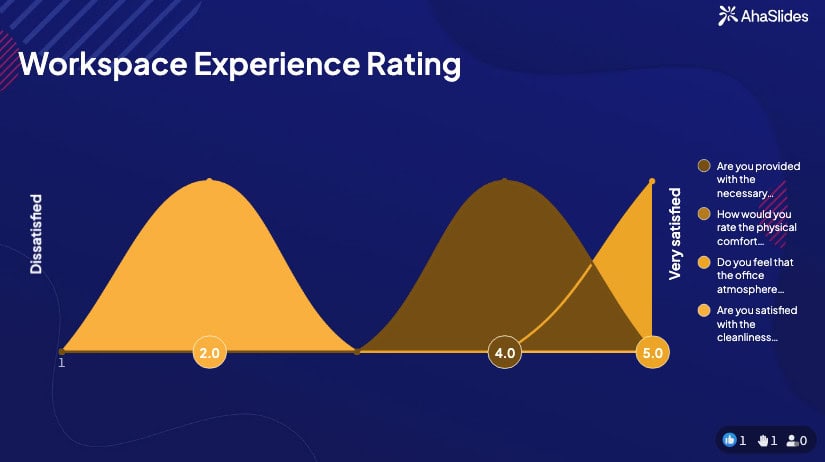
Şabloneke anketê ya jîngeha cihê kar biceribîne →
Uzunî Job
Pirs:
- Ma berpirsiyariyên karê we yên niha bi jêhatîbûn û jêhatîbûna we re têkildar in?
- Karên we bi zelalî hatine diyarkirin û ji we re têne ragihandin?
- Ma we fersend hene ku hûn pirsgirêkên nû bistînin û jêhatîyên xwe berfireh bikin?
- Ma hûn ji cûrbecûr û tevliheviya karên xwe yên rojane razî ne?
- Ma tu hîs dikî ku karê te armanc û têrkeriyê dide te?
- Hûn ji asta desthilatdariya biryardanê ya ku we di rola we de heye memnûn in?
- Ma tu bawer dikî ku berpirsiyariyên karê te bi armanc û mîsyona giştî ya rêxistinê re li hev dikin?
- Ma ji we re rêwerz û hêviyên zelal ji bo kar û projeyên we têne peyda kirin?
- Hûn çiqasî hest dikin ku berpirsiyariyên karê we beşdarî serkeftin û mezinbûna pargîdaniyê dibe?
Nêzîkatiya înteraktîf bi AhaSlides re:
- Ji bo pirsên zelalkirinê anketên erê/na pêşkêş bikin (mînak, "Ma karên we bi zelalî hatine destnîşankirin?")
- Ji bo astên razîbûnê pîvanên nirxandinê bikar bînin
- Bi Pirs û Bersîva vekirî bişopînin: "Hûn dixwazin çi berpirsiyariyan lê zêde bikin an jê bibin?"
- Ewrek peyvan çêke: "Rola xwe bi sê peyvan rave bike"
Pro tip: Taybetiya Pirs û Bersîva anonîm li vir bi taybetî bi bandor e. Karmend dikarin bêyî tirsa ku bên naskirin pirsên wekî "Çima di biryardanê de xweseriya me zêdetir nîne?" bişînin, ev yek dihêle ku rêvebir bi eşkereyî pirsgirêkên sîstemîk çareser bikin.
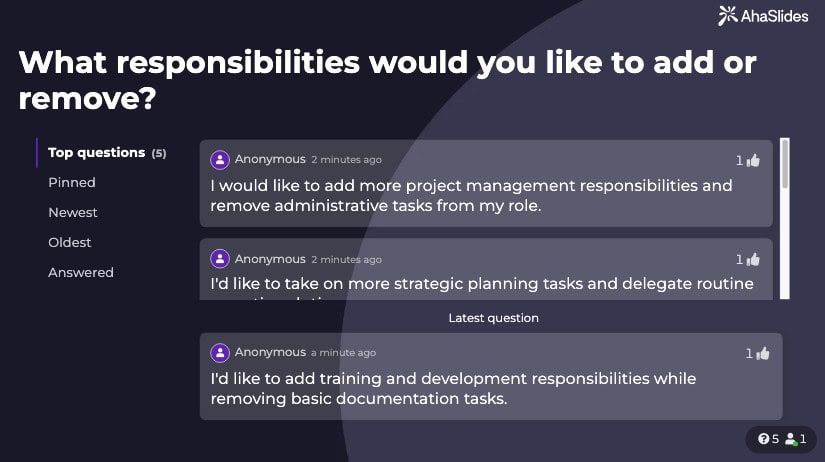
Çavdêrî û Rêbertî
Pirs:
- Hûn ê qalîteya pêwendiya di navbera we û serpereştyarê xwe de çawa binirxînin?
- Ma hûn li ser performansa xwe bertek û rêbernameyên çêker distînin?
- Ma hûn têne teşwîq kirin ku hûn nerîn û pêşniyarên xwe ji serpereştiya xwe re bibêjin?
- Ma tu hîs dikî ku rêveberê te girîngiyê dide beşdariyên te û hewlên te nas dike?
- Ma hûn ji şêwaza serokatî û nêzîkatiya rêveberiya di hundurê beşa xwe de razî ne?
- Hûn difikirin ku kîjan celeb jêhatîyên serokatiyê dê di tîmê we de herî bibandor bin?
Nêzîkatiya înteraktîf bi AhaSlides re:
- Ji bo nerîna hesas a serperiştên pîvanên nirxandinê yên anonîm bikar bînin
- Vebijarkên şêwaza serokatiyê pêşkêş bikin (demokratîk, rahênan, veguherîner, hwd.) û bipirsin ka kîjan karmend tercîh dikin.
- Pirs û Bersîvên zindî çalak bikin ku tê de karmend dikarin li ser rêbaza rêveberiyê pirsan bipirsin
- Rêzkirinê biafirînin: "Di serpereştekî de ji bo we çi herî girîng e?" (Ragihandin, Naskirin, Nirxandin, Xweserî, Piştgirî)
Çima nenasbûn girîng e: Li gorî pelê we yê pozîsyonê, pisporên çavkaniyên mirovî hewce ne ku "cihên ewle ji bo nîqaşên rast biafirînin". Anketên anonîm ên înteraktîf di dema civînên şaredariyê de dihêle ku karmend bêyî fikarên kariyerê bi awayekî rastgoyî serokatiyê binirxînin - tiştek ku anketên kevneşopî bi awayekî bawerbar bi dest dixin, têdikoşin.
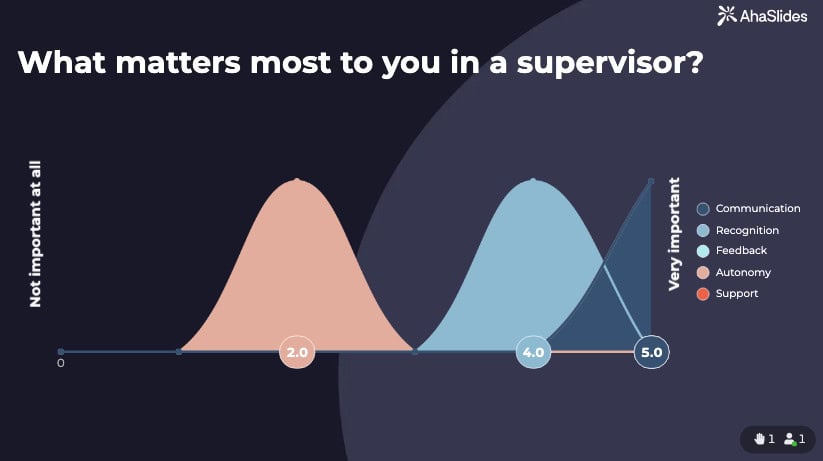
Pêşveçûn û Pêşkeftina Kariyerê
Pirs:
- Ji bo mezinbûn û pêşkeftina pîşeyî ji we re derfet têne peyda kirin?
- Tu çiqas ji bernameyên perwerde û pêşkeftinê yên ku ji hêla rêxistinê ve têne pêşkêş kirin razî yî?
- Ma hûn bawer dikin ku rola weya heyî bi armancên karîyera weya demdirêj re têkildar e?
- Ma ji we re şans têne dayîn ku hûn rola serokatiyê an projeyên taybetî bigirin?
- Ma hûn piştgirî distînin ji bo domandina perwerdehiya bêtir an pêşkeftina jêhatîbûnê?
Nêzîkatiya înteraktîf bi AhaSlides re:
- Anket: "Çi cure pêşketina pîşeyî dê ji we re herî zêde sûdmend be?" (Perwerdehiya Rêbertiyê, Jêhatîbûnên Teknîkî, Sertîfîka, Mentorî, Tevgerên Alîkî)
- Ewrê Peyvan: "Tu piştî 3 salan xwe li ku dibînî?"
- Pîvana nirxandinê: "Hûn di pêşveçûna kariyera xwe de çiqas piştgirî hîs dikin?" (1-10)
- Pirs û Bersîvên vekirî ji bo karmendan da ku li ser derfetên pêşveçûnê yên taybetî bipirsin
Avantaja stratejîk: Berevajî anketên kevneşopî ku ev dane di tabloyek hesaban de cih digirin, pêşkêşkirina pirsên pêşkeftina kariyerê di dema nirxandinên sê mehan de bi awayekî zindî dihêle ku HR di cih de budçeyên perwerdeyê, bernameyên mentoriyê û derfetên tevgera navxweyî nîqaş bike dema ku axaftin çalak e.
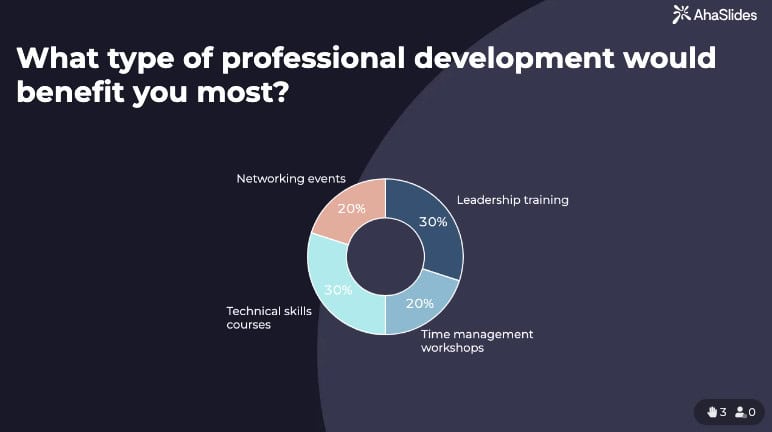
Tezmînatê û nehfên
Pirs:
- Ma hûn ji meaş û pakêta tezmînata xwe ya heyî, di nav wan de feydeyên dravî jî razî ne?
- Ma hûn hest dikin ku beşdarî û destkeftiyên we bi guncan têne xelat kirin?
- Ma feydeyên ku ji hêla rêxistinê ve têne pêşkêş kirin berfireh in û ji bo hewcedariyên we guncan in?
- Hûn şefafî û dadmendiya nirxandina performansê û pêvajoya tezmînatê çawa dinirxînin?
- Ma hûn ji derfetên bonûs, teşwîq, an xelatan razî ne?
- Tu ji siyaseta betlaneya salane razî yî?
Nêzîkatiya înteraktîf bi AhaSlides re:
- Anketên erê/na yên anonîm ji bo pirsên hesas ên mûçeyan
- Pirbijartî: "Kîjan feyde ji bo we herî girîng in?" (Lênêrîna Tenduristiyê, Nermbûn, Budceya Fêrbûnê, Bernameyên Tenduristiyê, Teqawidbûn)
- Pîvana nirxandinê: "Li gorî beşdariya we, tezmînata me çiqas adil e?"
- Ewrê peyvan: "Kîjan feyde dê razîbûna we herî zêde zêde bike?"
Têbînîyeke krîtîk: Ev e cihê ku anketên înteraktîf ên anonîm bi rastî jî dibiriqin. Karmend kêm kêm di anketên kevneşopî de ku hewceyê nasnameyên têketinê ne, bersivên rasteqîn ên tezmînatê didin. Anketên zindî yên anonîm di civînên şaredariyê de, ku bersiv bê nav xuya dibin, ewlehiya psîkolojîk ji bo bersivên rastîn diafirîne.
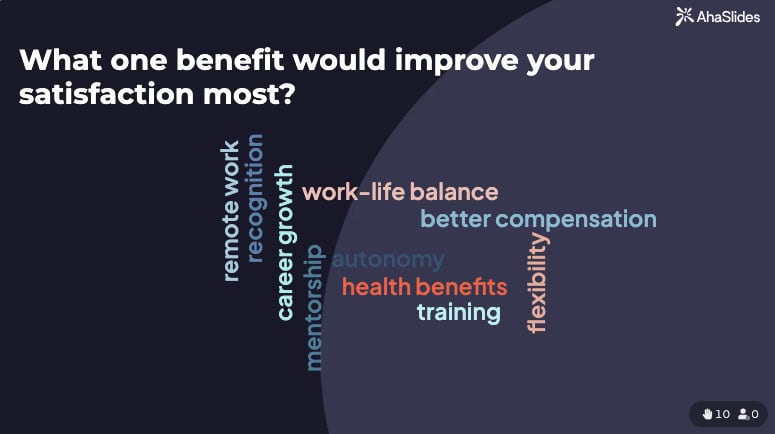
Rûniştina nirxandina tezmînata xwe biafirîne →
Têkilî û Hevkarî
Pirs:
- Hûn çiqas bi hevkarên xwe re hevkarî û danûstandinê dikin?
- Ma hûn di hundurê beşa xwe de hestek hevaltî û xebata tîmê hîs dikin?
- Tu ji asta rêzgirtin û hevkariya di navbera hevalên xwe de razî yî?
- Derfetên we hene ku hûn bi hevkarên ji beş an tîmên cûda re têkilî daynin?
- Ma hûn bi rehetî li alîkariyê an şîretan ji hevkarên xwe ger hewce ne?
Nêzîkatiya înteraktîf bi AhaSlides re:
- Pîvanên nirxandinê ji bo kalîteya hevkariyê
- Ewrê Peyvan: "Çanda tîmê me bi peyvekê rave bike"
- Pirbijarte: "Hûn çend caran di navbera beşên cuda de hevkariyê dikin?" (Rojane, Heftane, Mehane, Kêm caran, Qet nebe)
- Pirs û Bersîvên Anonîm ji bo eşkerekirina pirsgirêkên navkesane
Refah û Balansa Kar-Jiyanê
Pirs:
- Tu çiqas ji hevsengiya kar û jiyanê ya ku ji hêla rêxistinê ve tê peyda kirin razî yî?
- Ma hûn di birêvebirina stresê û domandina xweşiya giyanî de ji hêla pargîdaniyê ve bi têra xwe piştgirî hîs dikin?
- Ma hûn rehet li arîkarî an çavkaniyan digerin ji bo birêvebirina kêşeyên kesane an yên kar?
- Tu çend caran beşdarî bernameyên tenduristiyê an çalakiyên ku ji hêla rêxistinê ve têne pêşkêş kirin dibî?
- Ma hûn bawer dikin ku pargîdanî qîmetê dide refaha karmendên xwe û ew girîngiyê dide wan?
- Ma hûn di warê rehetî, ronahî û ergonomîk de ji hawîrdora xebata laşî razî ne?
- Rêxistin çiqas baş pêdiviyên we yên tenduristî û rehetiyê pêk tîne (mînak, demjimêrên nerm, vebijarkên xebata ji dûr ve)?
- Ma hûn xwe teşwîq dikin ku gava ku ji nû ve şarjkirinê hewce ye, navberan bidin û ji kar qut bibin?
- Hûn çend caran ji ber faktorên kar-girêdayî hûn xwe dişewitînin an stres dikin?
- Tu ji xizmetên tenduristî û xweşguzeraniyê yên ku ji hêla rêxistinê ve têne pêşkêş kirin razî yî?
Nêzîkatiya înteraktîf bi AhaSlides re:
- Pîvanên frekansê: "Çend caran hûn xwe stresdar hîs dikin?" (Qet nebe, Kêm caran, Carinan, Pir caran, Herdem)
- Anketên Erê/Na li ser piştgiriya başbûnê
- Sliderê Anonîm: "Asta şewitandina xwe ya niha binirxînin" (1-10)
- Ewrê peyvan: "Çi dê refaha te herî zêde baştir bike?"
- Pirs û Bersîvên vekirî ji bo karmendan da ku fikarên xwe yên başbûnê bi awayekî anonîm parve bikin
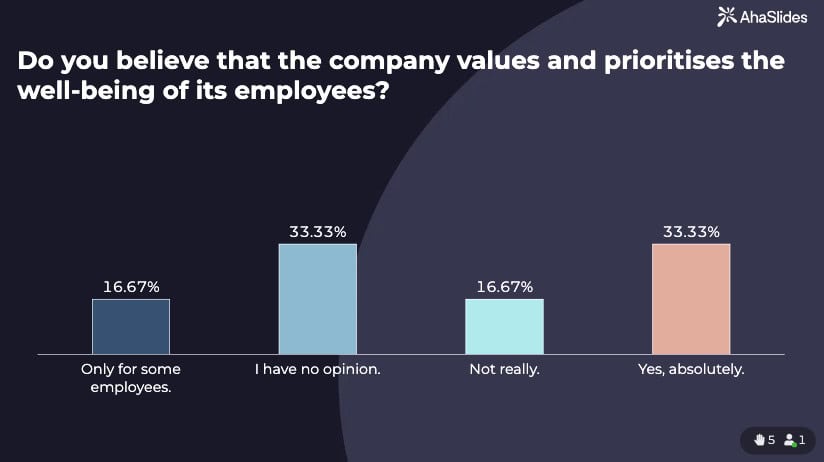
Çima ev girîng Pelê we yê pozîsyonê destnîşan dike ku pisporên çavkaniyên mirovî di "tevlîbûna karmendan û bersivdayînê" û "afirandina cîhên ewle ji bo nîqaşên rast" de têdikoşin. Pirsên li ser başbûnê bi xwezayî hesas in - karmend ditirsin ku heke ew qebûl bikin ku ew westiyane, qels an bêpabend xuya bikin. Anketên anonîm ên înteraktîf vê astengiyê ji holê radikin.
Têrkirina giştî
Pirsa dawî: 46. Li ser pîvana 1-10, çiqas îhtîmal e ku hûn vê şîrketê wekî cîhek xebatê ya baş pêşniyar bikin? (Pûana Pêşvebirina Netewî ya Karmendan)
Rêbaza înteraktîf:
- Li gorî encaman şopandin: Ger puan kêm bin, tavilê bipirsin "Ji bo baştirkirina puana we em dikarin çi biguherînin?"
- eNPS-ê di wextê rast de nîşan bide da ku serokatî hesta tavilê bibîne
- Encaman bikar bînin da ku danûstandinek zelal li ser başkirinên rêxistinî bimeşînin
Meriv Çawa Anketek Têrkeriya Karê Bi Bandor Bi AhaSlides Dimeşîne
Gav 1: Forma xwe hilbijêrin
Vebijêrka A: Zindî di dema civînên hemû-destan de
- Di civînên bajarî yên sê mehan de 8-12 pirsên sereke pêşkêş bikin
- Ji bo mijarên hesas moda anonîm bikar bînin
- Encaman tavilê bi komê re nîqaş bikin
- Baştirîn ji bo: Avakirina baweriyê, çalakiya tavilê, çareserkirina pirsgirêkên bi hevkariyê
Vebijêrka B: Bi leza xwe lê înteraktîf
- Girêdanek pêşkêşkirinê parve bike ku karmend dikarin her dem bigihîjinê
- Hemû 46 pirsan li gorî kategoriyê rêzkirî tê de bike
- Ji bo qedandinê muhletek destnîşan bikin
- Baştirîn ji bo: Berhevkirina daneyên berfireh, demjimêrek nerm
Vebijêrka C: Rêbaza hîbrîd (pêşniyaz kirin)
- 5-7 pirsên krîtîk wekî anketên xwe-bi lez bişînin
- Encamên heyî û 3 fikarên sereke di civîna tîmê ya bê de zindî werin pêşkêş kirin
- Ji bo kûrtirkirina pirsgirêkan, Pirs û Bersîvên Zindî bikar bînin
- Baştirîn ji bo: Beşdariya herî zêde bi nîqaşeke watedar
Pêngava 2: Anketa xwe li AhaSlides saz bikin
Taybetmendiyên ku bikar bînin:
- Pîvanên nirxandinê ji bo astên razîbûnê
- Anketên pir hilbijartî ji bo pirsên tercîhê
- Ewrên peyvê ji bo dîtina mijarên hevpar
- Pirs û Bersîva Vekirî ji bo ku karmend pirsên anonîm bipirsin
- Moda Anonîm ji bo misogerkirina ewlehiya psîkolojîk
- Nîşandana encamên zindî ji bo nîşandana şefafiyetê
Serişteya teserûfa demê: Ji bo ku hûn zû anketa xwe ji vê navnîşa pirsan biafirînin, jeneratora AI ya AhaSlides bikar bînin, dûv re li gorî hewcedariyên taybetî yên rêxistina xwe xweş bikin.
Gava 3: Armancê Ragihînin
Berî destpêkirina anketa xwe, rave bike:
- Çima hûn wê dimeşînin (ne tenê "ji ber ku dem ji bo anketên salane ye")
- Çawa bersiv dê werin bikar anîn
- Ku bersivên anonîm bi rastî anonîm in
- Kengî û çawa hûn ê encaman parve bikin û tedbîran bigirin
Senaryoya avakirina baweriyê: "Em dixwazin fêm bikin ka hûn bi rastî li ser xebata li vir çawa hîs dikin. Em anketên înteraktîf ên anonîm bikar tînin ji ber ku em dizanin ku anketên kevneşopî nerînên we yên rast nagirin. Bersivên we bê nav xuya dibin, û em ê encaman bi hev re nîqaş bikin da ku bi hev re çareseriyan pêş bixin."
Gava 4: Pêşkêşkirina Zindî (Heke Pêkan be)
Struktura civînê:
- Pêşgotin (2 deqe): Armanc û nenaskirinê rave bike
- Pirsên anketê (15-20 deqe): Anketan yek bi yek pêşkêş bikin, encamên zindî nîşan bidin
- Gotûbêj (15-20 deqe): Pirsgirêkên sereke tavilê çareser bikin
- Plansaziya çalakiyê (10 deqe): Pabendbûna bi gavên taybetî yên din
- Pirs û Bersîvên Piştî Dersê (10 deqe): Qada vekirî ji bo pirsên anonîm
Pro tip: Dema ku encamên hesas derdikevin holê (mînak, %70 ragihandina serokatiyê wekî xirab dibînin), tavilê wan qebûl bikin: "Ev nirxandinek girîng e. Werin em nîqaş bikin ka 'ragihandina xirab' ji bo we çi tê wateyê. Ji bo parvekirina mînakên taybetî bi awayekî anonîm, Pirs û Bersîvan bikar bînin."
Gava 5: Li gorî encaman tevbigerin
Li vir e ku anketên înteraktîf avantaja pêşbaziyê diafirînin. Ji ber ku we di dema axaftinên zindî de bersiv berhev kirine:
- Karmendan encaman berê dîtine
- Te soz daye ku bi awayekî giştî çalakiyan pêk bînî
- Şopandin tê çaverêkirin û xuya ye
- Bawerî ava dibe dema ku soz têne girtin
Şablona Plana Çalakiyê:
- Encamên berfireh di nav 48 demjimêran de parve bikin
- 3 deverên herî jor ên ji bo başkirinê destnîşan bikin
- Ji bo pêşxistina çareseriyan komên xebatê ava bikin
- Pêşveçûnê mehane ragihînin
- Ji bo pîvandina başbûnê piştî 6 mehan ji nû ve anket bikin
Çima Anketên Înteraktîf Ji Formên Kevneşopî Çêtir Dixebitin
Li gorî hewcedariyên rêxistina we, hûn hewce ne ku:
- "Di dema destpêşxeriyên HR de tevlêbûna karmendan bipîvin"
- "Li şaredariyan rûniştinên pirs û bersivan ên anonîm hêsan bikin"
- "Bi karanîna ewrên peyvan û anketên zindî, hestên karmendan berhev bikin"
- "Ji bo nîqaşeke rastgo cihên ewle biafirînin"
Amûrên anketê yên kevneşopî yên wekî Google Forms an SurveyMonkey nikarin vê ezmûnê pêşkêş bikin. Ew daneyan berhev dikin, lê diyalogê çênakin. Ew bersivên berhev dikin, lê baweriyê ava nakin.
Platformên înteraktîf ên mîna AhaSlides berhevkirina nerînan ji xebatek burokratîk vediguherînin guftûgoyek watedar. ko:
- Karmend dibînin ku dengê wan di wextê rast de girîng e
- Rêber pabendbûna tavilê ya guhdarîkirinê nîşan didin
- Nenasbûn tirsê ji holê radike, di heman demê de şefafî baweriyê ava dike
- Gotûbêj rê li ber çareseriyên hevbeş vedike
- Daneyên dibin destpêkerê axaftinê, ne raporek ku di kişandinê de rûdine
Key Takeaways
✅ Anketên razîbûna kar amûrên stratejîk in, ne qutiyên kontrolê yên rêveberiyê. Ew eşkere dikin ka çi tevlêbûn, ragirtin û performansê diafirîne.
✅ Anketên înteraktîf encamên çêtir didin ji formên kevneşopî - rêjeyên bersivdayînê yên bilindtir, nerînên rasttir, û derfetên nîqaşê yên tavilê.
✅ Nenasî û şefafî Ewlehiya psîkolojîk a ku ji bo bersivên rastîn hewce ye diafirîne. Karmend bi dilsozî bersiv didin dema ku dizanin bersiv anonîm in lê dibînin ku rêber tedbîran digirin.
✅ 46 pirsên di vê rêbernameyê de pîvanên girîng vedihewînin. ji razîbûna ji kar: jîngeh, berpirsiyarî, serokatî, mezinbûn, tezmînat, têkilî û refah.
✅ Encamên demrast dihêlin ku meriv di cih de dest bi çalakiyê bike. Dema ku karmend dibînin ku nerînên wan di cih de têne xuyang kirin û bi eşkereyî têne nîqaş kirin, ew hîs dikin ku têne bihîstin, ne tenê têne lêpirsîn kirin.
✅ Amûr girîng in. Platformên mîna AhaSlides bi anketên zindî, ewrên peyvan, pirs û bersivên anonîm, û nîşandana encamên demrast, pirsnameyên statîk vediguherînin sohbetên dînamîk ku guherîna rêxistinî dimeşînin.
Çavkanî:




